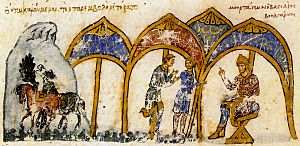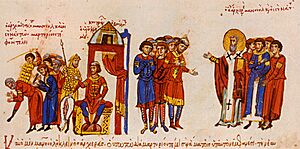Byzantine–Bulgarian treaty of 815 facts for kids
The Treaty of 815 (Bulgarian: Договор от 815) was an important peace agreement. It lasted for 30 years. This treaty was signed in Constantinople. It was between the Bulgarian ruler, Khan Omurtag, and the Byzantine Emperor Leo V the Armenian.
Contents
Why the Treaty Was Needed

Long wars had been fought between the Byzantine Empire and Bulgaria. These wars started around 756. When Khan Krum became the ruler of Bulgaria in 803, the fighting became very intense.
For over ten years, until he died in 814, Krum won many battles. He captured the important city of Serdica in 809. He also defeated the Byzantine armies in big battles at Varbitsa pass and Versinikia.
Krum's son, Omurtag, tried to continue his father's aggressive plans. But his military campaign in 814 was stopped by the Byzantines. Both countries were very tired from the long wars. So, they decided to start talking about peace.
How the Treaty Was Signed
In early 815, Khan Omurtag sent his representatives to Constantinople. Their goal was to negotiate peace. The signing ceremony was a very important event. Many people watched it happen.
The agreement stated that the Byzantine Emperor had to make promises using old Bulgarian traditions. Omurtag's representatives made their promises using Christian laws. Byzantine historians were very upset by the emperor's actions. They wrote that the "most Christian" ruler had to pour water on the ground from a cup. He also had to turn horse saddles around. He touched a special horse bridle and lifted grass high up. Another historian even said that Emperor Leo V had to cut up dogs to show his promise was serious.
What the Treaty Said
We don't have all the Byzantine records about the treaty's conditions. But the first two of its four parts are still known from a Greek inscription. This is called the Syuleymankyoy Inscription.
- First Part: The Border
This part set the border between Bulgaria and the Byzantine Empire. It started near the Black Sea coast at Debelt. It then followed an old trench called Erkesiya. The border went up to a river called Choban Azmak. From there, it reached the Maritsa river. It continued west to a village known today as Uzundzhovo. After that, the border went to a mountain, probably in the eastern Rhodope Mountains.
Historians believe that the area around Philippopolis (Plovdiv) was given to Bulgaria later. This happened after Byzantine soldiers slowly left the area. Until then, the border followed an older line. Bulgarians kept some forts near Adrianople as a guarantee. These forts were returned to the Byzantines later. This happened after Khan Malamir (831–836) took control of Philippopolis. This part of the treaty officially recognized Bulgaria's expansion to the south. However, Bulgarians had to return some towns they had taken, like Adrianople.
- Second Part: Prisoner Exchange
This part was about exchanging prisoners of war. The Bulgarians agreed to release Byzantines captured during Emperor Nikephoros I's campaign in 811. They also released people captured during later raids by Krum.
The Byzantines had to release Slavs captured by Leo V. They also released people living in border areas like Strandzha and the Rhodope. Some of these people had never been under Bulgarian rule. The treaty then gave details on how the exchange would happen. The Byzantines had to exchange one person for one person. They also had to give two cattle for every Byzantine soldier released. This was to make sure their soldiers returned home. This way, the Bulgarians helped reduce the number of Byzantine soldiers near the border.
What Happened Next
The treaty was good for Bulgaria. It also gave the Byzantines a much-needed break. They needed time to rebuild their armies after many defeats. They also faced new problems inside their own country. There was a disagreement about religious images, called iconoclasm.
Bulgaria also had its own religious issues. More and more people were becoming Christians. This worried Omurtag. The Khan started to persecute Christians. His oldest son, Enravota, was even killed because of this. The Bulgarians also needed to fix their economy. It had suffered from the bloody wars. Their capital city, Pliska, was still in ruins.
The peace treaty was confirmed again in 820. This happened when Emperor Michael II became the Byzantine ruler. Omurtag and Michael II also agreed to help each other if there was danger. Omurtag kept his promise. In 823, he helped stop a siege of Constantinople by a rebel named Thomas the Slav. Omurtag defeated Thomas's army.
|




